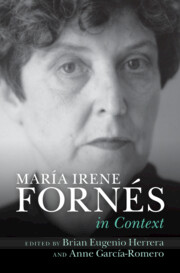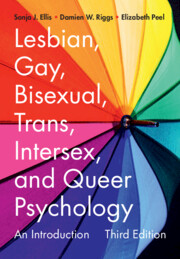Refine search
Actions for selected content:
52 results
35 - Queer Poetry in Australia
-
-
- Book:
- The Cambridge History of Australian Poetry
- Published online:
- 19 November 2025
- Print publication:
- 11 December 2025, pp 647-669
-
- Chapter
- Export citation

María Irene Fornés In Context
-
- Published online:
- 27 August 2025
- Print publication:
- 07 August 2025
Chapter 9 - Susan Sontag
- from Part I - Places and People
-
-
- Book:
- María Irene Fornés In Context
- Published online:
- 27 August 2025
- Print publication:
- 07 August 2025, pp 90-100
-
- Chapter
- Export citation
Chapter 22 - Lesbian
- from Part III - Culture, Society, and Politics
-
-
- Book:
- María Irene Fornés In Context
- Published online:
- 27 August 2025
- Print publication:
- 07 August 2025, pp 242-253
-
- Chapter
- Export citation

Performing Female Intimacy in Japan's Takarazuka Revue
-
- Published online:
- 26 July 2025
- Print publication:
- 28 August 2025
-
- Element
- Export citation
Introduction
-
- Book:
- After Equality
- Published online:
- 19 June 2025
- Print publication:
- 03 July 2025, pp 1-21
-
- Chapter
- Export citation
1 - Intersectionality and the Strategic Use of Identity in Social Movements
-
- Book:
- After Equality
- Published online:
- 19 June 2025
- Print publication:
- 03 July 2025, pp 22-41
-
- Chapter
- Export citation
8 - Un-Gendering ‘Somewhere’
- from Part II - The Work Itself and Its Context
-
-
- Book:
- The Cambridge Companion to <i>West Side Story</i>
- Published online:
- 09 January 2025
- Print publication:
- 09 January 2025, pp 135-153
-
- Chapter
- Export citation

Lesbian, Gay, Bisexual, Trans, Intersex, and Queer Psychology
- An Introduction
-
- Published online:
- 12 December 2024
- Print publication:
- 12 December 2024
-
- Textbook
- Export citation
2.6 - Queerness
- from History 2 - Mechanisms
-
-
- Book:
- The New Cambridge History of Russian Literature
- Published online:
- 31 December 2024
- Print publication:
- 12 December 2024, pp 313-332
-
- Chapter
- Export citation
3 - More Linguistic Matters: Aeolic Phonology and Morphology as Language Complexification
- from Part I - Aeolian and Aeolic
-
- Book:
- Aeolic and Aeolians
- Published online:
- 21 November 2024
- Print publication:
- 21 November 2024, pp 50-68
-
- Chapter
- Export citation
14 - Identification and Distance in Lucian’s Dialogues of the Courtesans: Subjects and Their Absences
- from Part II
-
-
- Book:
- The Cambridge Companion to Lucian
- Published online:
- 07 November 2024
- Print publication:
- 21 November 2024, pp 297-317
-
- Chapter
- Export citation
17 - Conclusion
- from Part III - Anatolian and Aeolian Myth and Cult
-
- Book:
- Aeolic and Aeolians
- Published online:
- 21 November 2024
- Print publication:
- 21 November 2024, pp 519-552
-
- Chapter
- Export citation
2 - The Aeolic Dialects
- from Part I - Aeolian and Aeolic
-
- Book:
- Aeolic and Aeolians
- Published online:
- 21 November 2024
- Print publication:
- 21 November 2024, pp 20-49
-
- Chapter
- Export citation
Predictors of new-onset suicide risk and persistent suicide risk among young adult lesbian, gay and bisexual individuals experiencing the COVID-19 pandemic: a follow-up study
-
- Journal:
- Epidemiology and Psychiatric Sciences / Volume 33 / 2024
- Published online by Cambridge University Press:
- 04 November 2024, e57
-
- Article
-
- You have access
- Open access
- HTML
- Export citation
7 - Where Gender, Sex and Mental Health Collide
-
- Book:
- Out of Her Mind
- Published online:
- 10 October 2024
- Print publication:
- 10 October 2024, pp 131-148
-
- Chapter
- Export citation
Introduction
-
- Book:
- Family Matters
- Published online:
- 27 May 2024
- Print publication:
- 01 August 2024, pp 1-28
-
- Chapter
- Export citation
3 - Son of a Bitch
-
- Book:
- Bitch
- Published online:
- 13 June 2024
- Print publication:
- 27 June 2024, pp 69-97
-
- Chapter
- Export citation
41 - Female Friendship
- from How to Recognize the Queer Past before (and during) the Advent of Medicalization
-
-
- Book:
- The Cambridge History of Queer American Literature
- Published online:
- 17 May 2024
- Print publication:
- 06 June 2024, pp 737-752
-
- Chapter
- Export citation
45 - The Pleasures of Reading Camp
- from How to Recognize the Queer Past before (and during) the Advent of Medicalization
-
-
- Book:
- The Cambridge History of Queer American Literature
- Published online:
- 17 May 2024
- Print publication:
- 06 June 2024, pp 801-817
-
- Chapter
- Export citation
